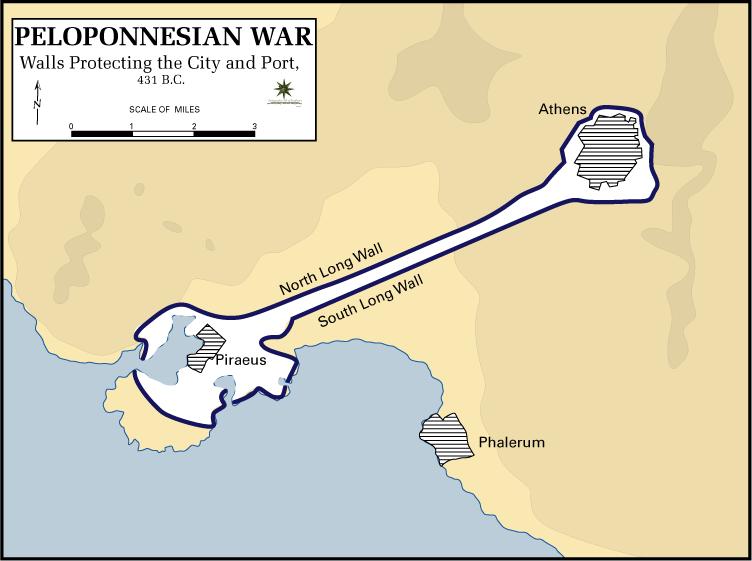To Read Part One, Click here: https://classicalwisdom.com/the-peloponnesian-war-summary-part-one/
The entirety of the Peloponnesian war is broken into two parts, punctuated by a brief, and probably very welcomed, armistice. The total engagement, with all its battles and betrayals, began in 431 BC and finally concluded with complete devestation in 404 BC. The first collection of campaigns, referred to as the “Archidamian War” after the Spartan king, lasted a full ten years.
The Plan of Attack for the land-loving Spartans and their allies was to surround the Athenians, thereby depriving them of their productive fields. This, however, was only partially effective because the Spartans could sustain siege for just a few weeks at a time. The hoplites, or infantrymen, were still farmers after all. They had to return to their own harvest and to quell the occasional slave uprising.
Nonetheless, Pericles, the Atheniangeneral, advised his men to not enter into combat with Sparta’s masterful soldiers on the ground. They would only fail. Instead, the Athenians, far superior in naval warfare, protected the access to their port with a formidable wall and relied on the dominance of their fleet to launch attacks against their enemy. So far, so good.
That’s when the plague hit. Perhaps more than any other factor, it was the sweeping disease that weakened Athens and brought the fair city to her knees. It wiped out over 30,000 citizens, sailors and soldiers, including their revered general and his sons. It is estimated that between one-third to two-thirds of the entire Athenian population perished.
After all the bodies had been disposed of, Athens renewed her military ambitions with emboldened hostility. The general who replaced Pericles, Cleon, embarked on an aggressive strategy for taking down the Spartans. The Athenians continued relentlessly with their naval raids, and stretched their military activities into Boeotia and Aetolia. In addition they began fortifying posts, one of which was near Pylos on a tiny island called Sphacteria. There the course of the first war turned in Athens’s favour.
Finally, things were looking up for Athens. They started taking advantage of Sparta’s greatest weakness: Helots. Helots were essentially slaves that made the Spartan system possible. By doing the farm work, they freed up the citizens’ time to become expert soldiers. However, they were also prone to revolts – and the Athenian presence at nearby posts helped spur them on. Without their working class, Sparta would have a hard time of surviving.
The Athenians rejoiced after the Battle of Pylos in 425, when they defeated the Spartans and captured between 300 and 400 soldiers. However, this joy did not last long. The Spartans fought back with their own belligerent general, Brasidas. He raised an army and took the Athenian silver mines, a crucial source of funding.
Interestingly enough, it was Thucydides, the famous historian, who was supposed to have saved the Athenian silver mines. Maybe it’s not so strange then that he said the following: “War is a matter not so much of arms as of money.”
However, Thucydides failed to arrive at the mines in time to defend them and consequently was exiled for his failure. Fortunately for us, this meant he was able to communicate with both sides, gaining a unique perspective which he later recorded in his major work, History of the Peloponnesian War.
The Athenians also knew that silver was pretty key. And so, they tried to retake their productive metallic mines… but, maybe not so tragically, the bellicose generals from both sides, Brasidas and Cleon, were killed in the fight. With no hawkish fame seekers to push the men into action, it was hard to keep warring. In fact, this resulted in the Peace of Nicias, which spanned 6 years.
‘Peace’, however, might be a little bit of an overstatement. There were still plenty skirmishes. Alliances were created and broken and large forces navigated the seas and lands… war was just a shot away.
Click HERE to read about the post peace Grecian breakdown in The Peloponnesian War Summary of Battles and Betrayals – Part Three: The Sicilian Expedition.
“The Peloponnesian War Summary of Battles and Betrayals – Part Two” was written by Anya Leonard












3 comments
Wasn’t the Athenian conquest of the poor folks of Melos during the supposed Peace of Nicias? Will you handle the dialog next time?
Interesting point! I think their idea of Peace is certainly not what I would consider peace… For instance, during that time there was the Battle of Mantinea, which was the largest land battle fought within Greece during the Peloponnesian War.
As for our next article – it should be on Phaedo :)
This is the shit m8!
Trackbacks
Our apologies, you must be logged in to post a comment.